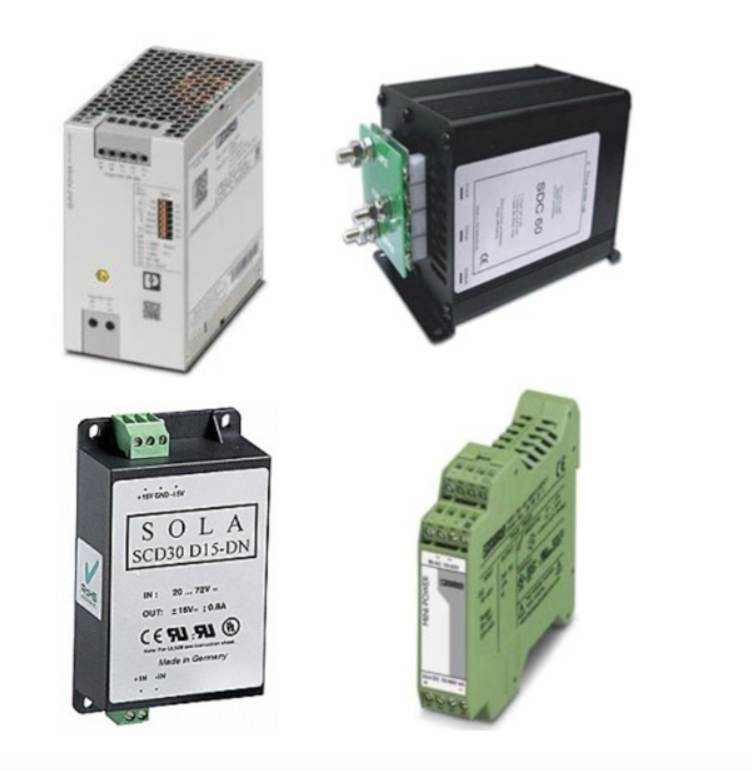DC to DC Voltage Converters

DC to DC converters are essential components used to regulate and convert direct current (DC) voltage levels within electrical and electronic systems. These devices accept a fixed or variable DC input voltage and convert it to a required output voltage, allowing equipment to operate safely and efficiently across a wide range of power conditions. They are widely used in industrial automation, telecommunications, automotive electronics, and embedded systems.
By maintaining stable output voltage and current, DC to DC converters help protect sensitive electronics from voltage fluctuations and power instability. Many converters are designed for high efficiency, minimizing energy loss and heat generation while supporting compact system designs. Common configurations include step-down (buck), step-up (boost), and buck-boost converters, each suited for specific voltage conversion requirements.
Buck converters are among the most commonly used DC to DC converters due to their efficiency and ability to deliver regulated lower voltages from higher input sources. These converters are ideal for applications with limited heat dissipation capacity and are frequently used in control cabinets, power distribution systems, and electronic devices that require consistent voltage regulation.
Overview – DC to DC Voltage Converters
DC to DC voltage converters are essential power management devices used to convert one level of direct current (DC) voltage to another. They ensure that electronic systems receive a stable and appropriate voltage, even when the input power source fluctuates. This makes them critical in applications where multiple devices operate at different voltage levels from a single power source. These converters are commonly used in automotive, marine, industrial, medical, renewable energy, and off-grid systems. Typical applications include stepping down 24VDC to 12VDC for control circuits, powering sensitive electronics, and maintaining consistent voltage for communication equipment, sensors, and control panels.
DC to DC converters are available in a wide range of current ratings, often from 5 amps up to 40 amps or more, allowing them to support both low-power electronics and higher-demand systems. Many models offer high efficiency, often exceeding 90% which minimizes heat generation and helps extend battery life in mobile or battery-powered applications. Modern DC to DC converters feature robust protection mechanisms such as over-voltage, over-current, short-circuit, and thermal protection to ensure safe and reliable operation. They are offered in both isolated and non-isolated designs, as well as various form factors including enclosed, DIN rail mount, open frame, and board-mount styles. With their ability to deliver regulated, efficient, and reliable DC power, DC to DC voltage converters play a vital role in ensuring system stability, protecting sensitive components, and simplifying power distribution across a wide range of electrical and electronic applications.
FAQs
Q: What is a DC to DC converter used for?
A DC to DC converter is used to convert one DC voltage level to another, providing stable and regulated power to electronic devices and systems.
Q: Do DC to DC converters provide a constant output voltage?
Yes, DC to DC converters are designed to maintain a constant output voltage even when the input voltage varies, ensuring reliable power delivery.
Q: Can analog circuits in a control cabinet use a step-down converter?
Yes, step-down converters are commonly used in control cabinets to reduce higher input voltages to stable, lower voltages suitable for sensitive analog circuits.
Q: What is a buck converter?
A buck converter is a type of DC to DC converter that steps down a higher input voltage to a lower regulated output voltage with high efficiency.
Q: What are DC to DC converters commonly used for?
DC to DC converters are widely used in automotive, marine, industrial, medical, renewable energy, and off-grid systems. They supply stable voltage to electronics such as control panels, sensors, communication devices, and battery-powered equipment.
Why Buy DC to DC Converters from RSP Supply
RSP Supply offers a comprehensive selection of DC to DC converters designed for reliable voltage regulation in industrial, automotive, and electronic applications. Our products support efficient power conversion, stable output performance, and integration into demanding environments. Customers rely on RSP Supply for technical expertise, dependable product quality, and power conversion solutions that support long-term system performance.

